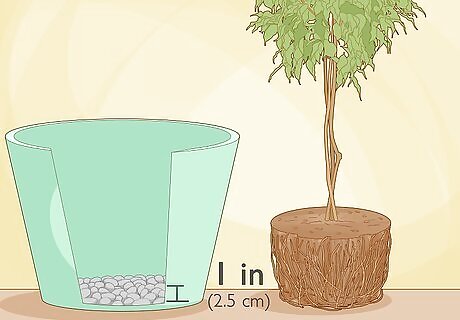
views
Prepping the Pot and Ficus

Repot your ficus tree in springtime, if possible. This is your ficus tree's strongest season—in winter, summer, and fall, your ficus tree may be less adaptable. If you can wait until spring to replant your plant, leave the plant in its current pot until then. Most ficus varieties thrive best if you repot them about once a year. Indoor ficus trees are generally more adaptable to repotting, even if the season isn’t ideal.

Repot your plant immediately if it has become pot-bound. Pot-bound plants are more prone to developing diseases or becoming starved of nutrients. If you notice any of the following signs, repot your plant as soon as you can: Stunted foliage growth Roots growing through the drainage holes Weak or wilting foliage

Remove the ficus carefully from its existing pot. Instead of tugging on the ficus, squeeze both sides of the container and turn it upside down. Tap the bottom of the pot until you loosen the plant and pull it out gently at the base. Tugging on the ficus tree can damage or remove its leaves and flowers. Have a friend stand near the upside down ficus to catch it if it falls out of the pot.

Choose a pot that is the same size or larger than the root system. Inspect your plant's root system after you pull it out and transplant it to a pot with the same depth. This will give your plant enough room to adapt without constricting the root system. If your plant's root system is too large, you can also cut back up to 20% of the root system. Trim along the outer areas of the plant's root system to keep the center roots intact and avoid cutting too much. Ficus plants prefer to be root-bound in their pots. Avoid choosing a pot that is significantly larger than the root system, as this can stunt the plant's growth.

Put a layer of rocks in the bottom of the pot. Place a 1 in (2.5 cm) layer of small rocks into the new pot. This will aid the pot in water drainage and prevent soggy soil. You can buy rocks suitable for plant containers at most garden centers or nurseries.
Transplanting the Ficus

Fill the pot partway with well-draining soil. Your ficus needs well-draining soil, preferably peat mix, to prevent it from becoming waterlogged. Add soil until the pot is about 1/4 to 1/2 of the way full—you will fill it up completely as you transplant the ficus. You can buy well-draining soil mixes at most nurseries or garden centers. Check the packaging for "well-draining" or ask an employee for assistance. To check soil drainage, dig a 1 foot (0.30 m) hole into the dirt and fill it with water. If the soil drains completely within 5-15 minutes, it is well-draining soil. Make sure that the new pot also has a few holes in the bottom to aid drainage.

Loosen the roots before replanting the ficus. Use your hands to loosen the root ball as much as you can without breaking it. This will help the ficus absorb more water and nutrients when you transplant it and adapt better to its new container.

Place your ficus into the pot and fill it with soil. Position the ficus tree upright into the pot. Fill the rest of the pot with soil until you reach the soil level of the plant's original level. Don't make your soil level any higher than the original container, which can suffocate the roots.

Place the pot in a spot with mild temperatures and bright lighting. Ficus trees prefer temperatures of around 60–75 °F (16–24 °C), or around room temperature. They also prefer bright, but not direct, sunlight. Whether you place your ficus tree indoors or outdoors, choose a spot with with moderate temperatures and lighting. Avoid spots with sudden temperature changes or cold drafts. Near a closed window, for example, is better than by an open door.
Caring for your Repotted Ficus

Water the ficus tree if the soil's top feels dry. Stick your finger into the soil—if the first inch or several centimeters feel dry, water your plant until the soil is moist. Check the soil every day for dryness. How often you need to water the plant may fluctuate based on the temperature, season, and humidity. Water your ficus immediately after planting or whenever you notice the top layer of soil drying out. During spring or summertime, fill a spray bottle with water and mist the ficus’s leaves daily.

Fertilize your plant 1-2 times a month during the spring and summer. During warmer seasons, spray a fertilizer over your ficus tree once every 2-4 weeks. In colder seasons, cut back to fertilizing the plant once monthly. Avoid fertilizing your plant more than once a month in winter when the tree is dormant. Diluted liquid fertilizers work best with ficus plants.

Clean your ficus leaves with a soft cloth. If your ficus leaves look dusty, dip a washcloth or sponge in lukewarm water. Gently wipe the surface of the leaves to keep them glossy and lustrous. Do not use dish soap or other cleaners to clean your ficus.

Prune the ficus in spring and early autumn. Use pruning shears or loppers to cut back excessive growth or deadwood. Avoid pruning near the tree trunk, which can damage your plant. Prune either before or after winter, the tree's dormant season.
















Comments
0 comment